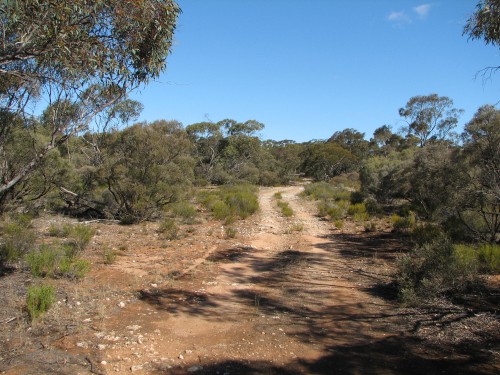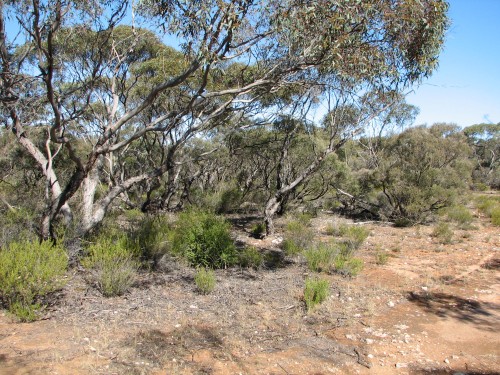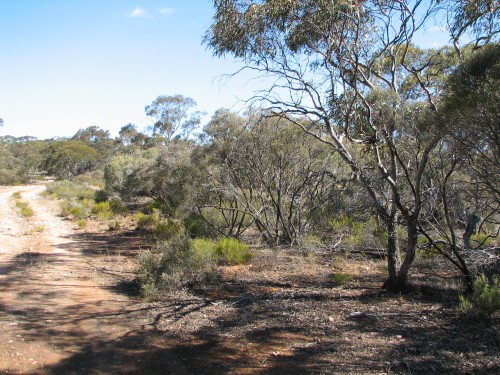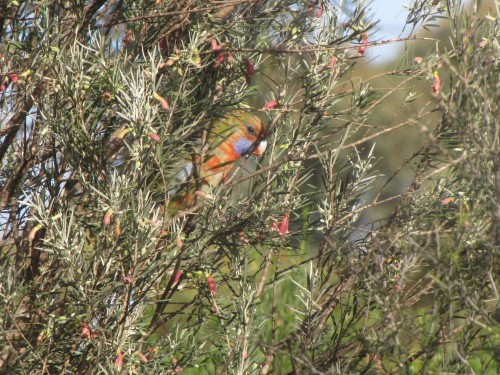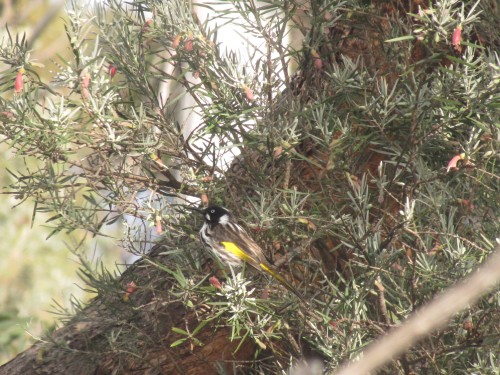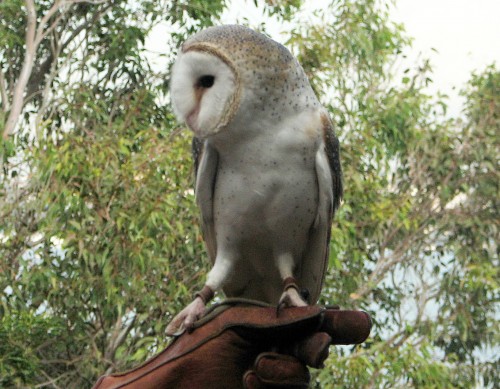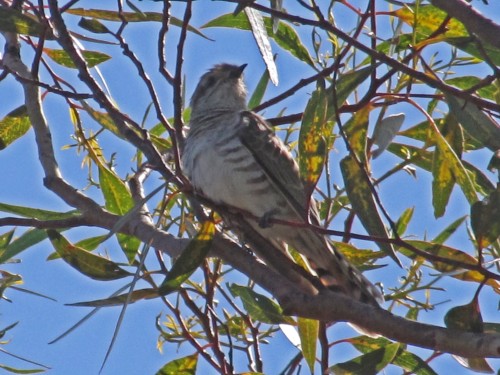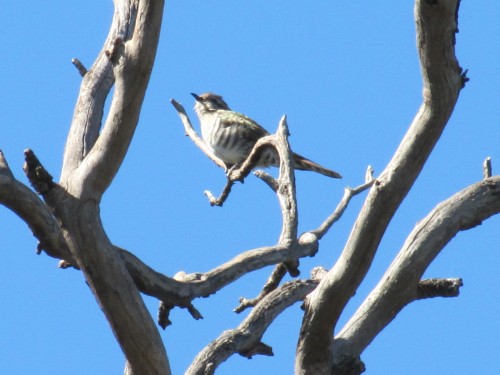Birding in Lowan Conservation Park
A few Sundays ago we had a break in our cold, wintry weather and we went for a drive to Lowan Conservation Park, a 40 minute drive north east from home in Murray Bridge, South Australia. The park is about 15 kilometres south east of Bowhill. I had visited this park on several previous occasions and found that the birding can be either a feast or a famine; it all depends largely on what is in flower, or the weather conditions.
The park is predominantly mallee woodland (see photos) with a mixture of other smaller scrubs and bushes. My wife has written about some of the plants on her site here.
On our most recent visit I didn’t even bother to take any photos; I saw no birds to photograph, well, none within range. And while we had our picnic afternoon tea in the sun I heard very little. It was a real struggle to get a short list of birds – mostly heard. (PS The photos on this post were taken on another visit.)
Bird list:
- Little Raven
- Mallee Ringneck
- Grey Shrike-thrush
- Weebill
- White-winged Chough
- Singing Honeyeater
- Australian Magpie
- Grey Butcherbird
- Galah
- Grey Fantail
- Noisy Miner? (or Yellow-throated Miner? – I only heard them)
- Striated Pardalote
That is not a great list, but there was not much flowering. In a park of some 660 hectares one would expect far more honeyeaters, but the mallee has to be in flower. Honeyeater species I would expect to see – or already have seen on other occasions – include: Striped, White-fronted, White-eared, White-plumed, Spiny-cheeked, Purple-gaped, Yellow-plumed, Brown-headed, New Holland and Red Wattlebird.
In addition to the honeyeaters I would expect to see more parrots, pigeons, wrens, thornbills, chats, woodswallows, robins (I did see one, but it flew off before I could get a positive ID), owls, nightjars, frogmouths, swallows, cuckoos, eagles, kites, falcons and even a Malleefowl or two. I have seen two Chestnut Quail-thrush there many years ago; I hope that they are still around.
I guess that the best time to visit would be in the spring, when there is a chance of more flowers. I think that it might be worth camping there overnight. By the way – there is only a rough, stony and sometimes sandy track through the park and NO facilities at all.
Trevor
Further reading:
Feeding Adelaide Rosellas
Last weekend we were having breakfast in our sun-room when four Adelaide Rosellas flew into one of the bushes in our garden, an Eremophila youngii (see photo above). I had the camera ready for many minutes but they would not come out into full sunlight and the above photo is the best I captured on this occasion. Just one bird is seen peeking out to see what was happening around it. The others were hidden in the foliage, busy feeding on the nectar in the flowers.
The Adelaide Rosella is now a frequent visitor to our garden. It is a race of the widespread Crimson Rosella and confined to the Adelaide region, Mt Lofty Ranges and mid-north of South Australia. Its occurrence here in Murray Bridge is a relatively recent extension of that range.
Parrots occurring in our garden in Murray Bridge include:
- Adelaide Rosella (regular visitor, possibly breeding)
- Crimson Rosella (occasional)
- Eastern Rosella (regular)
- Mallee Ringneck (resident breeding)
- Galah (resident breeding)
- Rainbow Lorikeet (regular)
- Purple-crowned Lorikeet (regular)
- Musk Lorikeet (occasional)
- Budgerigar (rare)
- Sulphur-crested Cockatoo (rare)
- Little Corella (occasional)
- Yellow-tailed Black-cockatoo (once only)
- Cockatiel (occasional)
- Red-rumped Parrot (occasional)
Over the years we have lived here we have planted many native Australian plants, not only for their attractiveness when they flower, but also to attract our native wildlife, especially the birds. We have quite a few eremophilas, grevilleas and correas as well as many others. The particular bush shown in the photo has flowers on it for much of the year so the rosellas and honeyeaters head for it on a daily basis. Below is another photo of the same bush, this time with a New Holland Honeyeater having a feed.
Further reading:
- Get out of my patch
- Red wattlebird in Eremophila bush
- Mallee Native Plants Nursery – my wife’s site about Australian plants
Ethical birding
In all of my birding life I have largely gone out by myself, or just with my wife and very occasionally with family such as my grand-children. Consequently, I have not been a witness to bad or questionable behaviour on the part of other birders.
I also tend to go out bush in the farming land near where I live where not many birders tend to congregate. Actually – that alone could explain why I sometimes do not get very long lists of birds observed, which could mean that I am going to the wrong spots.
Anyhow… I have just read an article in the news letter published by Birds SA. This article appeared in the August 2014 issue which indicates that I am a little behind with my reading. The then president of the association, David Paton, write in his regular letter to members an interesting article about ethical birding which is worth quoting here:
Ethical bird watching
“While bird watching, we all need to behave in ways that minimise disturbing the birds. This is particularly true in the breeding season, and many birds have already started breeding [in South Australia].
Ethical bird watching begins by first obtaining permission to be on a property and complying with any instructions from the owner or land manager.
Once on the land and watching birds one should:
- move away from any nests that are found;
- refrain from playing recordings of bird calls to lure birds in;
- limit the use of flash when taking pictures;
- respond appropriately if the birds are giving distractive displays, by moving away and not returning to the same area;
- not remove vegetation for a better view or photograph;
- think about the consequences for the birds of passing on details of rarer species or species that are nesting.
All these actions are about protecting the habitats and welfare of individual birds.”
David Paton, President, Birds SA in the August 2014 newsletter.
The above list gives plenty of wise advice on treating our birds with respect, and ways of caring for them and our environment.

For people living in Adelaide and other parts of South Australia, can I encourage you to become members of Birds SA? I have been a member now for over 35 years – somewhere I have a certificate to prove it.
For your membership your receive regular newsletters, journals, electronic updates, access to their weekly birding excursions, access to their monthly meetings and their extensive library of bird books. The monthly meetings always have interesting speakers, though I sadly don’t get to all that many meetings because of living in the country.
You can access their website here.
Good birding.
Cold weather birding
I didn’t do much birding today.
Or yesterday.
I decided that the weather was far too cold. We are having a really cold winter’s snap here in South Australia with heavy rain, very cold temperatures, blustery winds and even snow. Snow in our state is such a rarity it receives plenty of coverage in the news. We average one snow fall every few years and it only lasts a few moments on the ground – if it reaches the ground. Nothing like the countries where some of my readers reside, I know, but then you don’t have to contend with our severe summers which we take in our stride. Or our snakes. Or spiders. Or sharks… you get the picture?
Despite the cold, inclement weather I was still able to be aware of the birds in and around our home and garden. The New Holland Honeyeaters and Red Wattlebirds were busily feeding on a few native plants and trees which are currently flowering. The Australian Magpies have stopped fussing about whether it is time to start building nests yet. A small party of White-browed Babblers scratched their way through the leaf litter a few days ago and the little family of Superb Fairy-wrens always seem to be happy to flit and hop around the garden, no matter what the weather dishes up.
Yesterday I noticed two Little Ravens scratching around in the grass I haven’t mowed recently. They seemed to be having a good feast. A few days ago I also heard several Grey Currawongs calling but they must have been just passing through our mallee scrub and not stopping. Earlier in the week I heard a Barn Owl screeching outside during the evening; we had visitors at the time so I didn’t go out searching for it.
Further reading:
- Just click on the name of any of the species mentioned in this post. A link will take you to photos and stories about each of the species mentioned. Reading those articles might help you to while away some poor weather in your part of the world.
An early Horsfield’s Bronze-cuckoo
I meant to write this post about two weeks ago. I have been distracted by other things; it happens.
First thing one morning just on two weeks ago I was on my way out and I heard the distinctive call of a Horsfield’s Bronze-cuckoo. I was running late for a meeting so I didn’t have time to track it down and get a photo but I know its call from years of hearing it around our home and garden. The photos I have shared today were taken some time ago and are not brilliant, but they give you a general idea of the appearance of this species.
What was interesting about this record is the early nature of the visit in late June. Most of the cuckoos we see and hear on our property are later in the year, especially around spring time when many species are nesting. I have also been reading quite a few reports online by other birders of various cuckoos appearing in southern Australia in recent weeks. One field guide I consulted claims that this species migrates to southern Australia and breeds from June to March, so it is not really all that early after all.
Sometimes I wonder if our birds actually read the field guides and follow the instructions therein.
